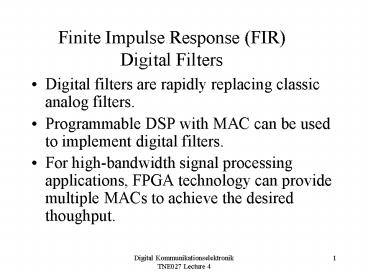Finite Impulse Response (FIR) Digital Filters - PowerPoint PPT Presentation
1 / 20
Title:
Finite Impulse Response (FIR) Digital Filters
Description:
... processing applications, FPGA technology can provide multiple MACs to achieve ... use of the repeated coefficients using the reduced adder graph (RAG) ... – PowerPoint PPT presentation
Number of Views:463
Avg rating:3.0/5.0
Title: Finite Impulse Response (FIR) Digital Filters
1
Finite Impulse Response (FIR) Digital Filters
- Digital filters are rapidly replacing classic
analog filters. - Programmable DSP with MAC can be used to
implement digital filters. - For high-bandwidth signal processing
applications, FPGA technology can provide
multiple MACs to achieve the desired thoughput.
2
- FIR Theory
- An FIR with constant coefficient is an Linear
Time-Invariant (LTI) filter. - The ouput of an FIR of order (or length) L, to an
input time-series xn, is given by a finite
version of the convolution sum - yn fnxn S fk xn-k
- where f0 ? 0 through fL-1 ? 0 are the
filters L coefficients. They also correspond to
the FIRs impulse response.
L-1
k0
3
- LTI system expressed in the z-domain
- Y(z) F(z) X(z)
- where F(z) is the FIRs transfer function defined
in z-domain by - F(z) S fk zk
- The roots of polynomial F(z) define the zeros of
the filter. FIRs are also called all zero filters.
L-1
k0
4
Direct Form FIR Filter
Tapped delay line
Fig. 3.1.
Tapped weight
5
FIR Filter with Transposed Structure
- A variation of the direct FIR model is called
the transposed FIR filter. It can be constructed
from the direct form FIR filter by - Exchanging the input and output
- Inverting the direction of signal flow
- Substituting an adder by a fork, and vice versa
6
FIR Filter in the Transposed Structure
Fig. 3.3. See Example 3.1 Programmable FIR
Filter
7
Comparison of the two forms of the FIR filter
- The direct form FIR filter needs extra pipeline
registers between the adders to reduce the delay
of the adder tree and to achieve high throughput.
- The FIR filter with transposed structure has
registers between the adders and can achieve
high throughput without adding any extra pineline
registers.
8
Symmetry in FIR Filters
- Define the center point of an odd-order FIRs
impulse response as the 0th sample - F(z) S fk zk
- (An even-order FIR can be similarly defined.)
- Linear-phase FIR filter
- Linear-phase is achieved if the filter is
symmetric or antisymmetric. - See Table 3.1.
k(L-1)/2
k-(L-1)/2
9
Linear-phase even-order filter with reduced
number of multipliers
fL-1
fL-2
Fig. 3.5. L L/2, where L is an even number.
10
Constant Coefficient FIR Design
- There are only a few applications, e.g., adaptive
filters, where we need a general programmable
filter. - In many applications, the filters are Linear Time
Invariant (LTI) and the coefficients do not
change over time. - The hardware effort can be reduced for constant
coefficient FIR.
11
Direct FIR implementation
- In a practical situation, the FIR coefficients
are obtained from a computer design tool and
presented to the designer as floating point
numbers. - The performance of a fixed-point FIR, based on
the floating-point coefficients, should be
verified using simulation or algebraic analysis
to ensure that design specifications remain
satisfied.
12
- Dynamic range overflow should be avoided.
- The worst-case dynamic range growth G of an Lth-
order FIR is - G ? log2(S fk)
- See Example 3.2 Four-tap direct FIR filter.
L-1
k0
13
Improve the direct FIR design
- Realize each filter coefficient with an optimal
CSD code. - Increase effective multiplier speed by
pipelining. - For FIR with symmetric coefficients, the number
of multipliers can be reduced. - See Table 3.3 and Example 3.3.
14
Rephasing pipelined multiplier in FIR filter
Add a positive delay fnz d fn z -d
15
FIR Filter with Transposed Structure
- If the transposed filter has constant
coefficients, two improved designs should be
considered - Multiple use of the repeated coefficients using
the reduced adder graph (RAG) algorithm - Pipeline adders
16
Reduced Adder Graph
- Algorithm 3.4 Reduced Adder Graph
- Remove the sign of the coefficient.
- Remove all coefficients and factors that are a
power of two. - Realize all cost 1 coefficients.
- Use cost 1 coefficients in building the
multiplier of higher cost. (Use Table 2.3.) - See Example 3.5.
17
Reduced Adder Graph for F6 Half-band Filter
Fig. 3.11. Realization of F6 using RAG algorithm
18
FIR Filter Using Distributed Arithmetic
- Distributed Arithmetic Using Logic Cells
- See Example 3.6 Distributed Arithmetic Filter
as State Machine. - Logic cells are used to implement small look-up
tables for low-order filters. - The outputs of a collection of low-order filters
can be added together to define the output of a
high-order FIR. - See Example 3.7 Five-input DA Table.
19
- DA Using Embedded Array Blocks
- It is not economical to use the 2-kbit EABs for a
short FIR filter, mainly because the number of
available EABs is limited. - The maximum registered speed of an EAB is 76 MHz,
and an LC table implementation may be faster for
a short FIR filter. - For long filters, EABs have registered throughput
at a constant 76 MHz and routing effort is
reduced. - See Example 3.8 Distributed Arithmetic Filter
using EABs.
20
Example 3.10 Loop Unrolling for DA FIR Filter
Fig. 3.16 Parallel implementation of a
distributed arithmetic FIR filter































